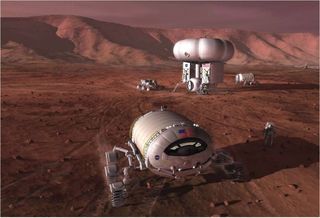
Donald Trump won't be president when NASA launches its first crewed mission to Mars.
During a call with NASA astronauts aboard the International Space Station (ISS) last month, Trump said he'd like the space agency to get people to the Red Planet "during my first term or, at worst, during my second term."
Such a request would seriously accelerate NASA's "Journey to Mars" initiative, which is currently working to get astronauts to the vicinity of the Red Planet in the 2030s. But it now appears that Trump was just engaging in a playful back-and-forth with ISS astronauts Peggy Whitson and Jack Fischer, not stating a serious policy objective. [NASA and Trump: What Happened in Space in the 1st 100 Days (Video)]
White House officials have "asked us to look at the plan we have today, and see if we can keep going on that plan," NASA Acting Administrator Robert Lightfoot told reporters during a teleconference today (May 12). "They have not asked us to go to Mars by 2024."
Lightfoot's comments came during an update about the status of NASA's Exploration Mission 1 (EM-1), which will mark the first joint flight of the Orion capsule and huge Space Launch System (SLS) rocket. NASA is developing both Orion and the SLS to send astronauts to Mars and other deep-space destinations.
EM-1 will take Orion on a roughly three-week trip around the moon. The mission, which had been scheduled to take place in late 2018, will actually launch sometime in 2019, Lightfoot and Bill Gerstenmaier, NASA's human-spaceflight chief, announced during today's teleconference.
Gerstenmaier cited several reasons for the delay, including difficulty in procuring the large numbers of valves, wiring, avionics and other components needed for the giant rocket.
Get the Space.com Newsletter
Breaking space news, the latest updates on rocket launches, skywatching events and more!
"We're, frankly, having trouble going from a very small industrial base to now this big base we need," he said.
There also was an act of nature: In February, a tornado damaged NASA's Michoud Assembly Facility in New Orleans, where much of the core SLS and Orion infrastructure is built.
"The tornado was really unfortunate to us, and that really set us back in a big way," Gerstenmaier said.
Exactly when in 2019 EM-1 will lift off is unclear at the moment, but a target date should be firmed up in the next few months, Gerstenmaier and Lightfoot said.
The Trump administration had asked NASA to consider putting astronauts aboard EM-1, which was originally envisioned as an uncrewed mission. The space agency has now completed an internal evaluation of the crewed-EM-1 idea and has decided to stick with the original plan, Lightfoot and Gerstenmaier said today.
While the SLS has yet to take flight, Orion has one mission under its belt. In December 2014, the capsule launched atop a United Launch Alliance Delta IV Heavy rocket on an uncrewed mission to Earth orbit called Exploration Flight Test 1.
Follow Mike Wall on Twitter @michaeldwall and Google+. Follow us @Spacedotcom, Facebook or Google+. Originally published on Space.com.
Join our Space Forums to keep talking space on the latest missions, night sky and more! And if you have a news tip, correction or comment, let us know at: community@space.com.

Michael Wall is a Senior Space Writer with Space.com and joined the team in 2010. He primarily covers exoplanets, spaceflight and military space, but has been known to dabble in the space art beat. His book about the search for alien life, "Out There," was published on Nov. 13, 2018. Before becoming a science writer, Michael worked as a herpetologist and wildlife biologist. He has a Ph.D. in evolutionary biology from the University of Sydney, Australia, a bachelor's degree from the University of Arizona, and a graduate certificate in science writing from the University of California, Santa Cruz. To find out what his latest project is, you can follow Michael on Twitter.
